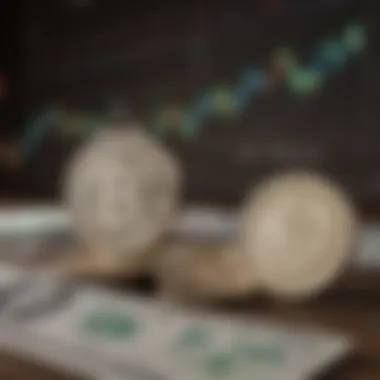Mastering Forex Trading: Strategies and Insights


Investment Terminology
To comprehend Forex trading thoroughly, it's paramount to grasp the terminology connected to it. This foundation serves as the cornerstone for understanding the mechanics behind currency trading.
Key Definitions
- Forex (Foreign Exchange): This refers to the marketplace for trading currencies. It’s a global, decentralized market where all the world's currencies trade.
- Pip: Short for "percentage in point", a pip is the smallest price move that can occur in the Forex market. It's typically the fourth decimal place in most currency pairs.
- Lot: A lot is a standardized quantity of currency being traded. The standard lot size is 100,000 units of currency. There are also mini lots (10,000) and micro lots (1,000).
- Leverage: Leverage allows traders to control a larger position with a smaller amount of capital. For example, if you have a 100:1 leverage, you can control $100,000 with $1,000.
- Currency Pair: This is the quotation of two different currencies, with one being the base currency and the other the quote currency. For example, in EUR/USD, the Euro is the base currency and USD is the quote currency.
Commonly Used Terms
- Spread: This is the difference between the bid price (the price at which you can sell) and the ask price (the price at which you can buy). It indicates the cost of trading.
- Margin: Margin is the amount of money that a trader must deposit to open a position. It serves as a good faith deposit.
- Order Types: This includes various commands traders use, such as market orders, limit orders, and stop-loss orders, to buy or sell currencies.
Expert Advice
Investment Strategies
- Trend Following: This strategy involves analyzing charts and trading in the direction of the trend. If the market is trending upwards, traders buy; if downwards, they sell.
- Scalping: Scalping is about making small profits on many trades throughout the day. This requires quick decision-making and being alert to market shifts.
- Swing Trading: Swing traders hold onto their positions for several days. They aim to capture price swings in the market. This requires patience and an eye for market indicators.
Risk Management Tips
- Use Stop-Loss Orders: Always set a stop-loss to limit potential losses. This acts as a safeguard in the unpredictable Forex market.
- Diversify Your Portfolio: Don’t put all your eggs in one basket. Spread your investments across different currency pairs to mitigate risk.
- Trade with a Plan: Have a detailed trading plan to navigate the markets. This should incorporate your risk tolerance, profit goals, and time frames.
"Successful traders are not driven by greed but by a structured plan and strict risk management."
In the ever-evolving landscape of Forex trading, understanding fundamental terms and strategies is essential. Knowledge empowers investors to make informed and confident decisions, sustaining their journey through the twists and turns of the currency market.
Prelude to Forex Trading
Forex trading, at its core, involves exchanging one currency for another. This means that traders are constantly looking at the value of currencies against each other, hoping to capitalize on fluctuations. The charm of Forex lies in its potential for profitability, but that is just the tip of the iceberg.
The benefits of delving into Forex trading include the opportunity to diversify investments, catch short-term movements in markets, and engage with a truly global economy. Notably, the Forex market operates 24 hours a day, which offers flexibility incomparable to traditional stock markets.
When stepping into Forex trading, there are considerations that one must keep in mind. The speculative nature of this market can present significant risks, not just financial but emotional as well. One must become acutely aware of market volatility, economic indicators, and geopolitical events that can sway currency values.
In this opening section, we’ll explore what Forex trading entails in detail. The subsequent subsections will provide a look at its historical roots and growth, creating a robust understanding of its relevance in today's trading environment.
What is Forex Trading?
Forex trading, short for foreign exchange trading, is the process of exchanging one country's currency for another. This global marketplace facilitates currency transactions that can occur anywhere around the world, at any time. Basically, it’s the way that businesses, investors, and governments convert one currency into another, often to complete international trade transactions.
To put it simply, consider a business that imports goods from overseas. When the company needs to pay their supplier in a different currency, forex trading steps in as the mechanism to perform this transaction. The value of one currency against another�—expressed as an exchange rate—floats based on the supply and demand in the market.
Traders will buy one currency while simultaneously selling another, making money through changes in the exchange rate. For instance, if you buy the euro at a rate of 1.10 against the US dollar, and later sell it when it appreciates to 1.15, you've made a profit off that currency pair. This interplay of buying and selling is the lifeblood of Forex trading.
Historical Context of Forex Markets
Understanding the historical context of Forex markets provides invaluable insights into its current structure and operation. The origins of currency exchange date back to ancient civilizations, where the trading of goods often required some form of barter or a standardized medium of exchange.
Fast forward to the 20th century, the Bretton Woods Agreement of 1944 set up a system of fixed exchange rates tied to the US dollar, which was in turn linked to gold. This created a stable environment for international trade. However, as economies evolved, this fixed system became untenable, and by 1971, it collapsed into the floating exchange rate system we see today.
The turn of the millennium saw a massive surge in globalization and technological advancements. The rise of online trading platforms and electronic communications transformed how Forex trading is conducted, allowing anyone with internet access to participate in the market. This democratization has led to unprecedented levels of participation, from small retail traders to big institutional players, ringing changes in the very fabric of the Forex landscape.
"The history of Forex is a testament to the evolving nature of global trade and finance, showing how far we've come in a relatively short period."
In the next sections, we will dive deeper into the mechanics of Forex trading, examining the intricate workings and strategies that define this dynamic market.
Mechanics of Forex Trading
The mechanics of forex trading form the backbone of the entire foreign exchange market. Understanding these mechanics is essential for traders seeking to make informed decisions and develop effective strategies. When you break it down, it’s like knowing the engine of a car; without that knowledge, you might find yourself in some tricky situations. In essence, this section will highlight the key components, their benefits, and critical considerations to help individual investors and financial enthusiasts get a firm grasp on how to navigate this complex terrain.
Understanding Currency Pairs
Currency pairs are the fundamental building blocks of forex trading. Every time one currency is exchanged for another, it forms a pair. When you look at a currency quote like EUR/USD, you’re essentially saying how much of the second currency, the U.S. dollar, is needed to buy one unit of the first currency, the euro.
The knowledge of how these pairs function can’t be overstated since they illuminate the relationships between economies and how they interact with each other.
Common pairs like EUR/USD, GBP/JPY, and AUD/CAD often attract traders due to their volatility and trading volume.
Here are some key aspects about currency pairs:
- Major Pairs: Involve the most traded currencies, often paired against the U.S. dollar.
- Minor Pairs: Do not involve the U.S. dollar but are less liquid than major pairs.
- Exotic Pairs: Involve a major currency paired with a currency from a developing economy, carry higher risks but can offer greater rewards.
In short, a strong grasp of currency pairs enables traders to formulate strategies based on market trends and economic indicators, making it a crucial aspect of forex mechanics.
How Trading Works in Practice
The nuts and bolts of forex trading can at first appear daunting, but they essentially revolve around buying and selling currencies. Each act of trading involves speculating whether a currency will appreciate or depreciate in relation to another.
Using trading platforms, such as MetaTrader or cTrader, traders can execute orders with a few clicks, allowing for rapid responses to market conditions. Here’s a breakdown of the process:
- Choosing a Trade: Based on analysis, traders decide which pairs to trade.
- Placing Orders: Orders can be market orders, executed immediately at current prices, or limit orders, set for specific prices.
- Monitoring Position: Once a trade is active, traders continuously monitor their position and market conditions to optimize outcomes.
- Exiting the Trade: Positions are closed either manually or automatically based on predetermined criteria.
This blend of analytical thinking and practical execution defines the art of trading, allowing investors to tap into the fluctuations of the currency market. Without this understanding of how trading works in practice, one might find themselves lost in the fast-paced environment of forex.
The Role of Forex Brokers
Forex brokers serve as the intermediaries between traders and the interbank forex market. In a way, they act like the bridge linking individual investors to the vast oceans of currency exchange. Brokers come in many shapes and sizes, offering different services and account types.
Here’s a look at the roles brokers play:
- Providing Access: They give traders access to the trading platforms necessary to execute purchases and sales.
- Market Orders: Brokers facilitate the execution of market orders and provide liquidity to the market.
- Spreads and Commissions: They earn revenue through spreads—the difference between the bid and ask price—or via commissions on trades.
- Research and Analysis: Some brokers offer research resources, helping traders make more informed decisions.
It’s vital for traders to choose a broker that aligns with their trading style and offers competitive spreads, since this can significantly impact overall profitability. In short, understanding the brokerage landscape can empower individual traders to find their niche in the competitive world of forex trading.
"In the world of forex trading, a well-chosen broker is as essential as a sharp tool to a craftsman."


Being attuned to these mechanics sets the stage for a more sophisticated understanding of forex trading, enabling informed choices and informed strategies to harness the potential of the markets.
Key Concepts in Forex Trading
Understanding the fundamentals of Forex trading is vital for anyone entering this complex financial arena. The foreign exchange market operates on a different level when compared to traditional investment avenues. Therefore, grasping essential concepts not only empowers traders but also lays the groundwork for making informed decisions. It’s about more than just profits; it’s about developing a holistic perspective of how the market functions.
This section will delve into key concepts, bringing clarity to how currency trading operates. We’ll tackle important themes like pips, lots, leverage, bid and ask prices, and spreads. These topics form the heart of Forex trading, and understanding them can provide the tools necessary for effective trading strategies.
Pips, Lots, and Leverage Explained
When discussing Forex, the term pip often pops up. A pip, which stands for "percentage in point," is the smallest price move that a given exchange rate can make. It's typically the fourth decimal place in currency pairs. For instance, if the EUR/USD moves from 1.1050 to 1.1051, that's a movement of one pip. Solved, simple, right?
Next, we have lots. Trading in the Forex market usually happens in standardized amounts called lots. A standard lot is equal to 100,000 units of the base currency. However, there are also mini lots (10,000 units) and micro lots (1,000 units). This division allows traders to choose how much they want to invest based on their individual risk appetite.
Finally, we need to talk about leverage. This is a critical aspect of Forex trading as it allows traders to control larger positions with a relatively small amount of capital. For example, with a leverage ratio of 100:1, you can control $100,000 with just $1,000. While this can amplify profits, it also increases the risk of significant losses. Therefore, although leverage can be a trader's best friend, being cautious is essential.
Bid and Ask Prices
Bid and ask prices demonstrate the dual-sided nature of the Forex market. The bid price is the maximum price that a buyer is willing to pay for a currency, while the ask price represents the minimum price that a seller is asking for their currency. The difference between these two is particularly important; it’s known as the spread.
Understanding bid and ask prices is crucial for traders as it influences the costs associated with opening and closing positions.
- Bid Price: Price at which the trader can sell a currency.
- Ask Price: Price at which the trader can buy a currency.
- Spread: The difference between bid and ask prices, which goes to the broker as a commission.
Grasping these concepts enables traders to better gauge the market, ensuring they aren't caught off guard by commissions that erode profits.
Understanding Spreads
The concept of spreads is central in Forex trading as it directly impacts trading costs and profit margins. Spreads can be categorized into two main types: fixed spreads and variable spreads.
- Fixed Spreads: Stay the same regardless of market conditions. Ideal for those who prefer predictability in trading costs.
- Variable Spreads: Change based on market volatility and liquidity. They can expand dramatically during news releases or major economic events.
The wider the spread, the more the price must move in your favor for a trade to become profitable. Therefore, choosing a broker with competitive spreads can make a significant difference in trading experiences.
"Understanding these key elements can set a trader apart from the average crowd, helping navigate the Forex waters like a seasoned sailor."
Fresh insights and informed decisions derive from a solid grasp of these basic yet crucial concepts.
Market Analysis Techniques
In the realm of Forex trading, understanding Market Analysis Techniques is akin to holding a compass in an uncharted ocean. It's how traders make sense of the noise and chaos that characterizes currency markets. By delving into this subject, we can recognize vital trends, gauge shifts in sentiment, and ultimately make informed decisions that could mean the difference between profit and loss. The right analysis techniques equip traders with the insights necessary to interpret market movements effectively, enabling them to adapt to ever-changing conditions.
Fundamental Analysis in Forex
When it comes to Forex trading, Fundamental Analysis focuses on the economic and political forces that shape currency movements. Traders investing in this method examine various indicators such as GDP growth rates, employment figures, and inflation statistics, among others. These elements paint a comprehensive picture of a country's economic health, thereby influencing how its currency will move.
For instance, if a country's central bank signals an intention to lower interest rates, traders might anticipate a decline in that currency's value. This predictive nature is what makes fundamental analysis a key player in Forex. Additionally, geopolitical events—such as elections or trade agreements—can also have dramatic effects on currency stability. Thus, integrating news analysis into your trading can often lead to a better grasp of important market shifts.
"Successful traders are not just data-fed machines, they are strategic thinkers who can read between the lines of economic news."
Technical Analysis Overview
Technical Analysis takes an entirely different approach, leaning heavily on historical price data to forecast future movements. By utilizing charts and different indicators, traders try to identify patterns and trends that can offer insights into probable future performance. Common tools include Moving Averages, Relative Strength Index (RSI), and Fibonacci retracements.
For example, let’s say a trader notices that a currency pair has repeatedly bounced off a certain price level. This observation might suggest a support level, reinforcing the potential for further buying opportunities in the future. This technique hinges not just on price points but also on the study of volume and market psychology. Integrating technical analysis with fundamental indicators can provide a well-rounded viewpoint, combining the hard data with market sentiment.
Sentiment Analysis Importance
Sentiment Analysis digs into the collective emotions of market participants, gauging whether the overall market sentiment is bullish or bearish. It’s like tuning into the heartbeat of the market, giving traders cultural insights into whether traders are optimistic or fearful. A simple way to measure this might be through metrics like the Commitment of Traders report, which indicates how many traders are positioned in various currencies.
Understanding prevailing market sentiment can guide traders on the right path. If sentiment is overwhelmingly bearish, one might consider waiting for an upward correction before entering a trade, as markets frequently behave contrary to popular belief. Essentially, sentiment analysis functions as an additional layer of risk management, providing context to technical and fundamental signals.
Trading Strategies
When diving into the realm of Forex trading, the strategies you choose are like the compass guiding a ship through choppy waters. They shape how you buy, sell, and manage your investments, bringing clarity amid chaotically shifting market conditions. Implementing a sound trading strategy is pivotal not only for maximizing profit potential but also for aligning with your overall investment goals and risk tolerance.
Scalping Techniques
Scalping is often regarded as the art of making the quick buck. Traders who adopt this method aim to exploit small price movements, seeking to profit from a plethora of trades executed within minutes or even seconds. This approach requires a keen sense of market dynamics and a lightning-quick finger on the trigger. Most scalpers focus on high-frequency trading within liquid markets where spreads are tight. An essential element of this strategy is that it minimizes exposure to market fluctuations that can occur during longer holding periods.
- Pros:
- Cons:
- Fast profits that can accumulate quickly
- Less risk tied up in any single trade
- Ideal for day traders who thrive on rapid decisions
- Requires constant monitoring of the markets
- Transaction costs might eat into profits if not managed well
- Can lead to fatigue and emotional burnout due to the speed of trading
Day Trading Approaches
Day trading, in contrast to scalping, allows traders to enter and exit positions within a single trading day. It encompasses a variety of tactics ranging from technical analysis charts to news-based trading decisions. Unlike scalpers, day traders can hold positions for several hours, allowing for substantial profit out of notable price movements while still avoiding overnight market risks. Typical strategies include momentum trading or using breakouts.
- Pros:
- Cons:
- No overnight risks, providing peace of mind
- The potential for significant profit on larger moves
- Flexibility in terms of trading style
- Stressful as traders need to make split-second decisions
- Requires a thorough understanding of market conditions
- Time-consuming since trading decisions must be constantly evaluated


Swing Trading Strategies
Swing trading is like the trusty middle ground between day trading and positional trading. Traders hold their positions from overnight to several days, capturing short- to medium-term market moves. This approach benefits those who cannot commit several hours a day to trading but still want to take advantage of fluctuating prices. By using various tools like trend lines and moving averages, swing traders position themselves to catch larger price swings that occur periodically.
- Pros:
- Cons:
- Can yield substantial profits within a reasonable timeframe
- Requires less monitoring than day trading
- Flexibility allows traders to maintain a full-time job
- Risk of market gaps when holding positions overnight
- Potential for emotions to cloud judgment due to the waiting period
- Relies heavily on accurate market timing and analysis
Position Trading Insights
Position trading is an approach for those who are less concerned with short-term fluctuations and instead focus on long-term trends. By holding trades for weeks, months, or even years, position traders aim to capitalize on larger macroeconomic shifts. This strategy suits those who prefer a more laid-back trading style, often leveraging fundamental analysis to guide their decisions.
- Pros:
- Cons:
- Less stress due to infrequent trades
- Ability to withstand market volatility
- Long-term potential maximizes gains from significant trends
- Exposure to prolonged market risks
- Requires patience as profits are not immediate
- Emotional challenges may arise during downtrends
In the fast-paced world of Forex, your trading strategy can be your strongest ally or your fiercest enemy. Choose wisely!
Ultimately, each trading strategy has its own merits and drawbacks. The selection comes down to aligning your personal trading style and risk appetite with a method that suits your goals. Whether you decide to scalp, day trade, swing trade, or position trade, understanding the nuances of each approach can significantly alter your path in the challenging terrain of Forex trading.
Risk Management in Forex
In the realm of Forex trading, managing risk is akin to navigating a minefield – one misstep can lead to costly repercussions. Each decision made in the trading arena carries the weight of potential gains or losses, underscoring the necessity of a robust risk management strategy. Effective risk management serves as a safety net, helping traders to preserve capital and ensure the longevity of their trading activities.
The benefits of risk management are manifold. First and foremost, it encourages disciplined trading. Traders who understand risk management principles are likely to stick to their trading plans, reducing the influence of emotions such as greed or fear. Moreover, a sound risk management approach can turn trading into a more predictable venture, as it enables traders to assess the probability of success against potential losses.
Incorporating risk management into your trading strategy isn’t merely advisable; it’s essential. It helps establish a protective framework, allowing the trader to engage with the volatility of the Forex market with a clearer perspective.
Identifying Risks in Forex Trading
Identifying the various risks associated with Forex trading is the bedrock of any risk management plan. Traders must hone their ability to recognize potential hazards that may affect their positions. These risks can manifest in several forms:
- Market Risk: The most obvious risk comes from price fluctuations of currency pairs. Political events, economic announcements, and other market-moving news can lead to swift changes.
- Leverage Risk: Using leverage can amplify gains, but it also heightens the potential for losses. New traders may not fully grasp how quickly leveraging can amplify their risks.
- Liquidity Risk: In certain market conditions, finding buyers or sellers can be challenging, posing a risk of executing trades at unfavorable prices.
Traders are advised to keep their fingers on the pulse of news and events that may cause sudden shifts in the market. By doing so, they can better prepare for an unpredictable landscape.
Utilizing Stop Loss and Take Profit
One of the key tools in a trader's risk management arsenal is the use of stop loss and take profit orders. These mechanisms serve to automate the decision-making process when it comes to closing trades, thereby minimizing emotional influences.
- Stop Loss Orders: This is a predicated point where a trader decides to pull the pin, preventing further losses. By setting a stop loss, traders know precisely how much they are willing to risk on a particular trade. It acts as a buffer against market swings.
- Take Profit Orders: On the flip side, a take profit order specifies when a trader wishes to close a position to secure a profit. This ensures that traders don’t hold onto winning trades too long, thus avoiding the temptation to wait for an even larger gain.
Using these orders requires a degree of foresight. Traders must assess market conditions and set levels that reflect realistic targets while balancing risk and reward.
Effective Position Sizing
Position sizing is another fundamental aspect of risk management. Essentially, it involves determining how much capital to allocate to a given trade, taking into account both the risk level and the trader's overall account balance.
Maintaining prudent position sizes is crucial for long-term success. A common rule of thumb is the 1% rule, which suggests that no more than 1% of a trading account should be risked on a single trade. This helps to prevent significant losses that can derail a trading career.
Key Factors to Consider for Position Sizing:
- Account Size: The larger the account, the more capital can be allocated per trade without exceeding risk limits.
- Risk Tolerance: Each trader’s capacity for risk varies, and position sizing should align with individual comfort levels.
- Market Conditions: During high volatility, traders may need to reduce their position sizes to mitigate the risks of rapid price changes.
By understanding and implementing effective position sizing strategies, traders can navigate the complexities of Forex markets with greater confidence and resilience.
Psychology of Trading
Trading isn't just about graphs, charts, or economic indicators; it’s a nuanced dance of human emotions, fear, hope, and instinct. When individuals dive into the world of Forex trading, understanding the psychological factors that drive decision-making is essential. This section aims to dissect the critical elements of trader psychology, explore the emotional landscape, and establish a robust trading mindset.
Understanding Trader Psychology
Trader psychology is the study of the emotional and mental aspects influencing traders’ decisions in the Forex market. It encapsulates a myriad of factors such as greed, fear, confidence, and overthinking, which can steer the course of performance.
- Fear of Loss: Many traders become paralyzed by the anxiety of losing money. This trepidation often leads to hesitation in executing trades or holding onto losing positions far too long, hoping the market will turn around.
- Greed for Gains: On the flip side, the desire to profit can prompt traders to take excessive risks. Chasing after unrealistically high returns rather than sticking to a well-laid strategic plan can be detrimental.
- Overconfidence: As novices gain a bit of experience, it’s common to feel invincible about predictions. Overconfidence can result in complacency, where traders forgo their usual analysis checks and become susceptible to mistakes.
"The biggest enemy in trading isn't the market; it's the doubts and emotions within us."
Recognizing and dissecting these psychological traps is crucial not only for individual profit margins but also for maintaining overall market stability.
Managing Emotions While Trading
It’s said that emotions are the wind that can either fill the sails or capsize the ship. Thus, being conscious of them is a must. Let’s delve into some ways traders can keep a tight rein over their sentiments:
- Develop a Trading Plan: Having a comprehensive plan mitigates impulsive behaviors. A plan outlines entry and exit points, positions sizes, as well as risk management techniques, allowing traders to stick to a strategy even when emotions run high.
- Practice Mindfulness: Mindfulness exercises can greatly benefit traders. Techniques such as meditation can help cultivate awareness, ensuring decisions are made from rationality rather than knee-jerk reactions.
- Keep a Trading Journal: Documenting each trade helps track what went well and where feelings may have influenced choices. By reviewing decisions, traders can identify patterns tied to emotional responses, enabling them to strategize accordingly.
- Limit Trade Size: Sometimes, less is more. By trading smaller sizes, the pressure diminishes. This can lead to more objective decision-making rather than allowing fear or greed to cloud judgment.
Building a Trading Mindset
Crafting a resilient trading mindset leans heavily on the foundation built by understanding one's emotional responses. Here's how traders can cultivate this mindset:
- Patience is Key: Trading isn't a sprint. Cultivating patience fosters the ability to wait for the right opportunities. Jumping at the first signal often leads to regret.
- Continuous Learning: The Forex market evolves rapidly. A successful trader prioritizes ongoing education, which can range from market analysis to psychological strategies. Staying informed helps maintain confidence and reduce panic during volatile conditions.
- Accepting Losses: Losses are part and parcel of trading. Acknowledging that losing is inevitable helps in fostering resilience. It allows traders to approach the next opportunity with a level head instead of dwelling on past setbacks .
- Feedback Loops: Regular reflection on trading experiences creates a healthy feedback loop. This can inform future strategies and help in dealing with emotional responses within the trading sphere.


By emphasizing the importance of psychology in trading, one can create an environment where emotional understanding aids in prudent decision-making. Merging tactical trading with a sound psychological approach makes for a more holistic way to tackle the Forex markets.
Technological Advances in Forex
In the dynamic world of Forex trading, technology plays a pivotal role in shaping strategies, optimizing processes, and enhancing traders' experiences. It streamlines complex operations and provides tools that allow individual investors and financial enthusiasts to navigate the market more effectively. Understanding these technological advances is essential for any trader looking to thrive in the competitive foreign exchange landscape.
The Impact of Algorithms and Automation
Algorithms have fundamentally changed the mechanics of Forex trading. By using complex mathematical models and heuristics, traders can automate their trading processes. This automation offers several benefits:
- Speed: Orders can be executed in milliseconds, which is crucial in a market that can shift on a dime.
- Emotion-Free Trading: Algorithms eliminate the emotional component, allowing for more logical decision-making.
- Back-testing: Traders can test their strategies against historical data before implementing them in real-time, minimizing potential losses.
However, while the advantages are enticing, reliance on algorithms also comes with risks. Algorithms can lead to unforeseen consequences if market conditions change rapidly or if there's a flaw in the coding.
"In the fast-paced arena of Forex, the wrong algorithm can spell disaster. A trader must stay vigilant to ensure that automation does not create blind spots in judgment."
Mobile Trading Applications
With the rise of smartphones, mobile trading applications have revolutionized how traders access Forex markets. These apps allow traders to execute trades from nearly anywhere, providing the convenience of trading on-the-go. Key features often include:
- Real-time Alerts: Traders can set alerts for price movements, ensuring they're always in the loop.
- User-Friendly Interfaces: Modern apps prioritize ease of use, making it simple for even novices to trade effectively.
- Security Features: Most reputable apps include advanced security protocols to protect user data and funds.
Yet, while mobile trading has empowered many, it also encourages certain pitfalls. Traders might find themselves constantly distracted by market fluctuations, leading to impulsive decisions. Balancing the convenience of mobile trading with mindful strategy formulation is vital.
The Rise of Social Trading Platforms
Social trading platforms have brought a novel dimension to Forex trading. These platforms enable traders to share insights, strategies, and even their trading operations with others, creating a community feel in an otherwise solitary pursuit. Key benefits include:
- Access to Collective Knowledge: Beginners can learn from seasoned traders by observing their strategies.
- Copy Trading: Many platforms allow users to automatically replicate the trades of successful traders, making it easier for newbies to get started.
- Community Support: Forums within these platforms often provide moral support and technical help, enhancing the trader's journey.
Nonetheless, social trading has its challenges. Simply following another trader’s path doesn’t guarantee success; it’s essential to analyze their strategies critically and adapt them to one’s risk tolerance and investment goals.
Understanding these technological advances is not just about recognizing the tools available; it’s about grasping how they reshape the very landscape of Forex trading. Embracing technology can significantly enhance one’s trading strategy, and staying informed in this area is crucial for anyone wanting to excel in the Forex arena.
Regulatory Environment
The world of Forex trading operates within a framework that is both dynamic and complex. Understanding the regulatory environment is crucial for anyone looking to engage in this market. Regulations help foster transparency, prevent fraud, and ensure market integrity. Without these measures, the Forex landscape could be rife with malfeasance, putting traders’ investments at significant risk.
Understanding Forex Regulations Globally
Globally, regulations surrounding Forex trading are far from uniform. Countries have adopted various frameworks based on their economic landscapes and governance styles.
- European Union: The regulation in the EU is largely guided by the Markets in Financial Instruments Directive II (MiFID II). This legislation aims to enhance investor protection and increase competition. Brokers must adhere to strict guidelines regarding capital adequacy and transaction reporting.
- United States: The Forex market here is closely overseen by the Commodity Futures Trading Commission (CFTC) and the National Futures Association (NFA). Their stringent requirements help protect retail traders from fraud and ensure that brokers operate honestly.
- Australia: The Australian Securities and Investments Commission (ASIC) regulates Forex activities. Their regulations are generally considered pro-trader, allowing foreign brokers to operate under certain conditions while ensuring high levels of protection for investors.
Awareness of these regulations is vital for traders. Knowing what applies in your region not only minimizes the risk of running afoul of local laws but also enhances overall trading safety.
Ensuring Compliance with Local Laws
Compliance with local laws is paramount in Forex trading, mainly because traders must navigate varied regulations across different jurisdictions.
- Licensing: Always ensure that your chosen broker is licensed adequately in your home country. This adds a layer of security, as licensed brokers are required to adhere to local laws and standard operating practices.
- Tax Responsibilities: Different jurisdictions have unique tax implications for Forex traders. Understanding your obligations can prevent costly errors down the line. It’s advisable to consult with a financial advisor or tax consultant who specializes in Forex.
- Reporting Requirements: Some countries mandate reporting of Forex transactions for tax purposes. Familiarize yourself with how to keep records of your trades to remain compliant with such requirements.
In summary, staying informed and aligning your trading strategies within the regulatory framework provides peace of mind and a more stable trading experience.
Challenges in Forex Trading
Forex trading can be a thrilling venture, offering the prospect of substantial financial reward. However, it comes with its fair share of challenges. Recognizing these challenges is essential for any trader aiming to be successful in navigating these turbulent waters.
The importance of understanding the challenges inherent to Forex trading cannot be overstated. Knowing what hurdles could impede progress allows traders to formulate better strategies, enhancing their chances of long-term success. Some of the most significant challenges include high volatility and market fluctuations, alongside the overwhelming amount of information available. Tackling these issues can lead to informed decision-making and ultimately greater profitability.
High Volatility and Market Fluctuations
In the world of Forex, volatility is both a blessing and a curse. Currency values can swing wildly, influenced by factors like geopolitical events, economic reports, or sudden shifts in market sentiment. For instance, a minor change in interest rates by a central bank can cause significant movement in currency pairs. These unpredictable swings often make Forex an attractive option for quick profits. Yet, they also amplify the risk of significant losses.
Traders must develop a strong grasp of market indicators and stay ahead of news trends. Implementing strategies like stop-loss orders can sometimes help limit losses during extreme fluctuations. Recognizing that high volatility is a double-edged sword means that traders can prepare themselves mentally and strategically. They should always have a plan to navigate through the storms of the market’s unpredictability and, quite literally, learn to ride the waves.
"In the Forex market, it’s not about avoiding the waves, it’s about learning how to surf them."
Dealing with Information Overload
With the advent of technology, traders have access to a plethora of information at their fingertips. While this might sound like a good thing, it can lead to information overload. In Forex trading, too much information can cloud judgment. Economic news, social media chatter, expert analyses, and countless trading signals can confuse even seasoned traders.
Navigating this maze of information requires discipline. Traders must learn to filter out noise and focus on what really matters. Here’s a few tips to keep information as an asset rather than a liability:
- Create a trading checklist: Focus on key indicators that influence your trades rather than digesting every piece of information.
- Set clear objectives: Knowing what your trading goals are helps to cut out unnecessary data.
- Limit sources: Choose a select few reliable sources for updates instead of trying to cover everything.
Addressing information overload can lead to clearer thinking and better decision-making, reducing stress and increasing confidence in trading strategies. Finding that balance is crucial for any trader working towards becoming a stalwart in the Forex arena.
Epilogue
In this conclusion, we bring together the threads of discussion that crisscross the world of Forex trading, highlighting its relevance and importance for anyone looking to partake in this dynamic arena. It’s important to understand that Forex trading is not just about buying and selling currencies; it’s a complex market that reflects the financial health of nations and economies. By grasping the fundamentals discussed throughout the article, an individual can navigate the intricacies of currency movements and better position themselves for potential gains.
Summarizing Key Takeaways
- Comprehension of Basics: The foundational concepts such as currency pairs, pips, and leverage are essential. Without a firm grasp on these, traders risk making uninformed decisions.
- Analysis Techniques: Whether one leans towards fundamental or technical analysis, having sharp analytical skills can significantly alter trading outcomes. Staying updated on economic indicators helps shape a robust trading strategy.
- Risk Management: As emphasized, effective risk management techniques – stop-loss and take-profit orders, and proper position sizing – can help mitigate losses and guard against unpredictable market swings.
- Psychological Preparedness: Managing emotions is crucial. The desire to react to market movement can lead to hasty decisions. Cultivating patience and discipline is key to long-term success.
- Technological Familiarity: With mobile trading apps and social trading platforms rising in popularity, modern traders need to embrace technology, utilizing advanced tools to enhance their trading strategies.
The Future of Forex Trading
The landscape of Forex trading is ever-evolving, influenced by technological advancements, regulatory changes, and shifting market dynamics. As we gaze into the crystal ball, it's clear that several trends are likely to shape the future:
- Automation & AI: The incorporation of algorithms and AI in trading practices continues to gain momentum. These technologies can analyze vast amounts of data far quicker than any human, offering insights that can lead to profitable trades.
- Decentralized Finance (DeFi): This emergent concept has the potential to disrupt traditional Forex trading by facilitating peer-to-peer trading without intermediaries. As it gains traction, traders will need to adapt to new systems and methods.
- Regulation Changes: Governments worldwide are continually re-evaluating regulations in response to the rapidly changing environment. Staying informed about these changes will be critical in maintaining compliance and safeguarding investments.
- More Educational Resources: The demand for knowledge in Forex trading grows. As retail trading rises, there are more resources, courses, and seminars available for both new and seasoned traders. Access to quality education is likely to foster a more informed trading community.
In summary, while the journey through Forex trading holds its challenges, the rewards for those who are well-prepared and informed can be substantial. The key lies in continuous learning, adaptability, and strategic thinking.















